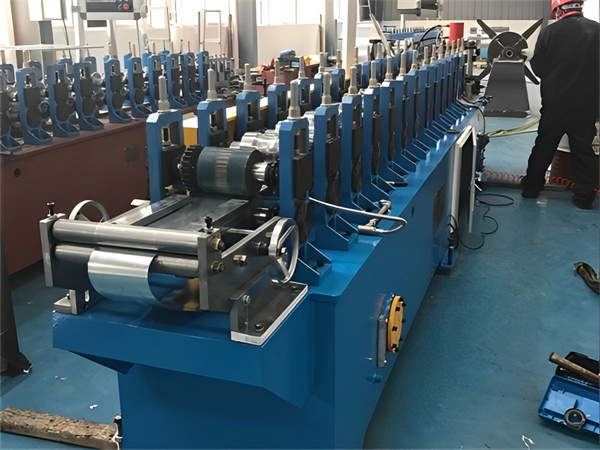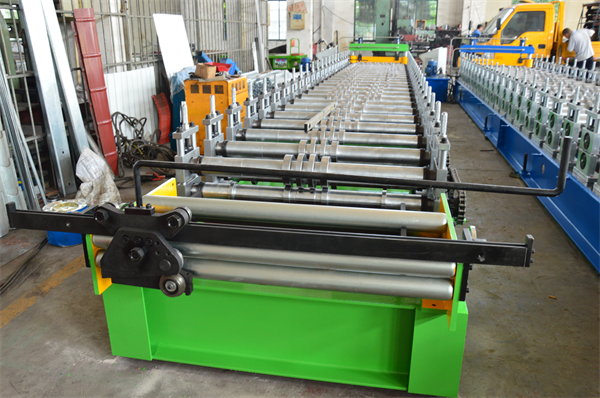Introduction
Roll forming is a pivotal process in modern manufacturing that allows for the cost-effective mass production of intricate metal profiles. From the seamless shaping of steel sheets to the creation of complex cross-sections, roll forming machine lines play an indispensable role in various industries. In this article, we will explore the different facets of roll forming technology, its applications, benefits, challenges, and the considerations involved in choosing and maintaining a roll forming machine line.

Components of a Roll Forming Machine Line
A roll forming machine line comprises several key components that work in harmony to transform raw materials into precise profiles. These components include:
Uncoiler and Coil Handling
The process begins with the uncoiler, which holds the coil of raw material (typically metal sheets). The material is fed through the machine line, undergoing a series of forming steps.
Stations de formage de rouleaux
Roll forming stations are the heart of the process. They consist of sets of rollers, each performing a specific bending or shaping action on the material as it passes through. The material gradually takes the desired shape with each station.
Mécanisme de coupe
After forming, the material is cut into specific lengths using cutting mechanisms. This can include flying cut-off systems or hydraulic shears, ensuring precision in the final products.
Système de contrôle
Modern roll forming machine lines incorporate advanced control systems that regulate the speed, alignment, and other parameters of the process. This automation enhances accuracy and reduces human intervention.
The amalgamation of these components facilitates the seamless creation of a wide array of profiles, from simple shapes to intricate designs used in various industries.
How Does a Roll Forming Machine Line Work?
The operation of a roll forming machine line follows a systematic process that transforms raw materials into accurately shaped profiles. Let’s delve into the step-by-step procedure:
- Alimentation en matériaux : The raw material coil is loaded onto the uncoiler. The material is then fed into the roll forming stations through a series of rollers, where each roller set performs a specific bending or shaping action.
- Gradual Forming: As the material progresses through the roll forming stations, it gradually takes the desired shape. Each station contributes to the overall profile by applying precise forces and bends.
- Roller Alignment: Ensuring proper alignment of the rollers is crucial to maintain the accuracy of the formed profile. Advanced control systems monitor and adjust the roller positions as needed.
- Coupe: Once the material has passed through the forming stations, it reaches the cutting mechanism. This mechanism cuts the continuous profile into individual lengths. Flying cut-off systems or hydraulic shears are often employed for this purpose.
- Collection and Stacking: The cut profiles are then collected and stacked for further processing or packaging. This stage is critical to prevent damage to the formed profiles.
- Quality Inspection: Roll forming machine lines incorporate quality control mechanisms to identify any defects or inconsistencies. These inspections can involve measurements, visual checks, and automated systems to ensure the final products meet specifications.
- Automation and Efficiency: The integration of automation systems allows for precise control over the entire process. This leads to consistent results, reduces human error, and increases production efficiency.

Advantages of Using Roll Forming Machine Lines
Roll forming technology offers a plethora of advantages that make it a preferred choice in various industries:
- Efficacité de production élevée : Roll forming machine lines can operate at high speeds, enabling the production of large quantities of profiles in a relatively short time.
- Consistent and Precise Results: The controlled and systematic process ensures uniform shapes and dimensions, resulting in high-quality and accurate profiles.
- Versatility in Product Design: Roll forming can accommodate a wide range of materials, including steel, aluminum, and even plastics. This versatility extends to the design of profiles, allowing for complex cross-sections and intricate shapes.
- Rapport coût-efficacité : The high-speed production, minimal material wastage, and reduced need for secondary operations contribute to cost savings in the long run.
- Minimal Tooling Changes: Unlike other forming methods that require frequent tooling changes for different shapes, roll forming can produce various profiles with minimal adjustments.
- Durabilité et solidité : The consistent shaping process enhances the structural integrity of the profiles, making them durable and capable of withstanding various loads and stresses.
Applications of Roll Forming Machine Lines
Roll forming finds extensive use across multiple industries due to its versatility and efficiency. Some notable applications include:
- Industrie automobile : Roll-formed components are commonly used in automotive structures, such as door frames, roof rails, and chassis reinforcements.
- Construction Sector: The construction industry relies on roll forming for producing metal studs, roofing panels, and various architectural profiles.
- Manufacturing of Consumer Goods: Roll-formed parts are integral to the production of appliances, furniture, and shelving units.
Roll forming’s adaptability makes it an essential process in both large-scale industrial settings and smaller manufacturing operations. It enables the creation of products that are functional, durable, and aesthetically pleasing.
Factors Influencing Roll Forming Machine Line Design
The design of a roll forming machine line is influenced by several key factors that ensure optimal performance and quality of the final products:
- Material Properties: The choice of material, its thickness, and mechanical properties significantly impact the design of the machine line. Different materials require varying levels of force and shaping precision.
- Complexité du profil : The complexity of the desired profile dictates the number of roll forming stations and the intricacy of the roller designs. More complex profiles might require additional stations and careful roller adjustments.
- Volume de production : The anticipated production volume affects the machine’s speed and automation capabilities. High-volume production lines may require faster speeds and automated material handling.
- Tolerance and Precision: The required tolerances and precision of the final profiles influence the design of the entire process. Tight tolerances demand higher control and monitoring systems.

Roll Forming vs. Other Metal Forming Techniques
Roll forming offers distinct advantages over traditional metal forming techniques like press braking and stamping:
- Material Conservation: Roll forming generates less material wastage compared to stamping, where scrap can be significant.
- Continuous Process: Roll forming is a continuous process, allowing for higher efficiency and quicker production compared to stop-and-start methods like press braking.
- Profils complexes : Roll forming can produce complex profiles that are challenging or impossible to achieve with stamping or press braking.
- Économies de coûts : The reduced material wastage, minimal secondary operations, and faster production times contribute to cost savings in roll forming.
- Cohérence : Roll forming’s systematic approach ensures consistent results across large production runs.
Ensuring Quality in Roll Formed Products
To maintain the quality of roll formed products, several measures should be implemented:
- Quality Control Checks: Regular inspections at various stages of the process ensure that formed profiles adhere to specifications.
- Roller Maintenance: Proper maintenance of rollers is essential for accurate shaping. Regular checks and replacements prevent profile defects.
- Inspection des matériaux : Quality raw materials are a prerequisite for quality profiles. Material inspections before processing are crucial.
- Precision Monitoring: Utilizing advanced monitoring systems ensures that the machine operates within specified tolerances.
Tendances futures de la technologie du laminage
Roll forming technology continues to evolve, driven by industry demands and technological advancements:
- Automation Integration: Increasing automation and robotics integration streamline processes and enhance efficiency.
- Durabilité : Adoption of sustainable practices, such as using recycled materials and optimizing energy consumption, is becoming more prevalent.
Choosing the Right Roll Forming Machine Line
Selecting the appropriate roll forming machine line involves several considerations:
- Compatibilité des matériaux : Ensure the machine is designed for the specific material you intend to use.
- Options de personnalisation : Look for machines that can be customized to match your required profiles.
- Volume de production : Choose a machine that aligns with your production volume needs.
- Assurance qualité : Opt for machines with built-in quality control mechanisms.

Maintenance and Upkeep of Roll Forming Machine Lines
Proper maintenance is vital for the longevity and performance of roll forming machine lines:
- Inspection régulière : Routine checks for wear and tear, misalignments, and potential issues are essential.
- Lubrification : Adequate lubrication of moving parts ensures smooth operation and prevents friction-related problems.
- Entretien programmé : Create a maintenance schedule for routine servicing and component replacements.
Stay tuned for more insights on this topic in the upcoming sections of this article.
Cost Analysis and Return on Investment
Investing in a roll forming machine line involves initial expenses, but the long-term benefits can outweigh the costs:
- Investissement initial : Consider the machine’s cost, installation, training, and any additional tooling or customization expenses.
- Production Cost Savings: Reduced material wastage, efficient production, and minimized labor requirements contribute to cost savings.
- Return on Investment (ROI): Calculate the ROI based on production volume, cost savings, and increased efficiency. A well-planned investment can yield substantial returns over time.
Case Studies: Successful Implementation
Real-world examples illustrate the effectiveness of roll forming machine lines:
- Industrie automobile : Many auto manufacturers utilize roll forming to create structural components that meet strict safety and precision requirements.
- Construction Applications: Roll-formed profiles are extensively used in construction projects due to their durability and ease of installation.
Challenges and Limitations of Roll Forming
Despite its advantages, roll forming has some challenges and limitations:
- Profils complexes : Highly intricate profiles might pose challenges in terms of design and maintaining dimensional accuracy.
- Material Limitations: Roll forming is most suitable for materials with consistent properties. Brittle or highly elastic materials might not be ideal.

Conclusion
In conclusion, a roll forming machine line is a cornerstone of modern manufacturing, enabling the efficient production of diverse profiles used in industries ranging from automotive to construction. The systematic process, precise results, and cost-effectiveness make roll forming an indispensable technology. By understanding the factors that influence machine design, the benefits it offers, and its potential limitations, businesses can make informed decisions when considering the adoption of roll forming technology.
FAQ
1. Is roll forming only suitable for metal materials? Roll forming is commonly used for metal materials, but it can also be adapted for other materials like plastics and composites.
2. How does roll forming compare to extrusion? Roll forming and extrusion are both metal shaping processes, but they differ in their principles and applications. Roll forming is particularly advantageous for creating continuous profiles, while extrusion is more suitable for creating solid shapes.
3. Can roll forming accommodate various thicknesses of material? Yes, roll forming can handle a range of material thicknesses, but adjustments to the machine may be necessary for different thicknesses.
4. What industries benefit the most from roll forming technology? Automotive, construction, and consumer goods manufacturing are among the industries that extensively benefit from roll forming technology.
5. Are there any environmental benefits to using roll forming? Yes, roll forming can contribute to sustainability by minimizing material wastage and energy consumption through efficient production processes.
